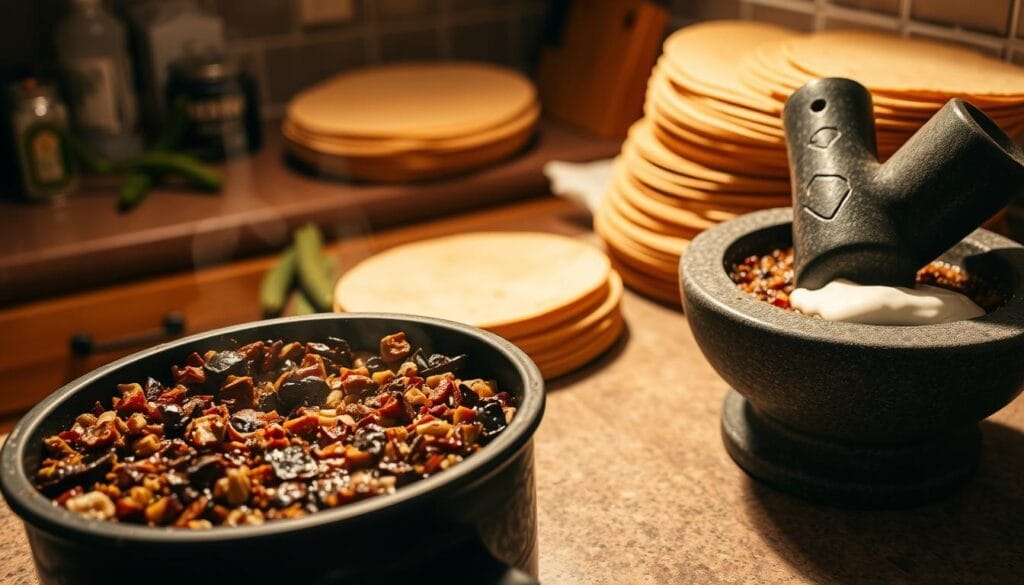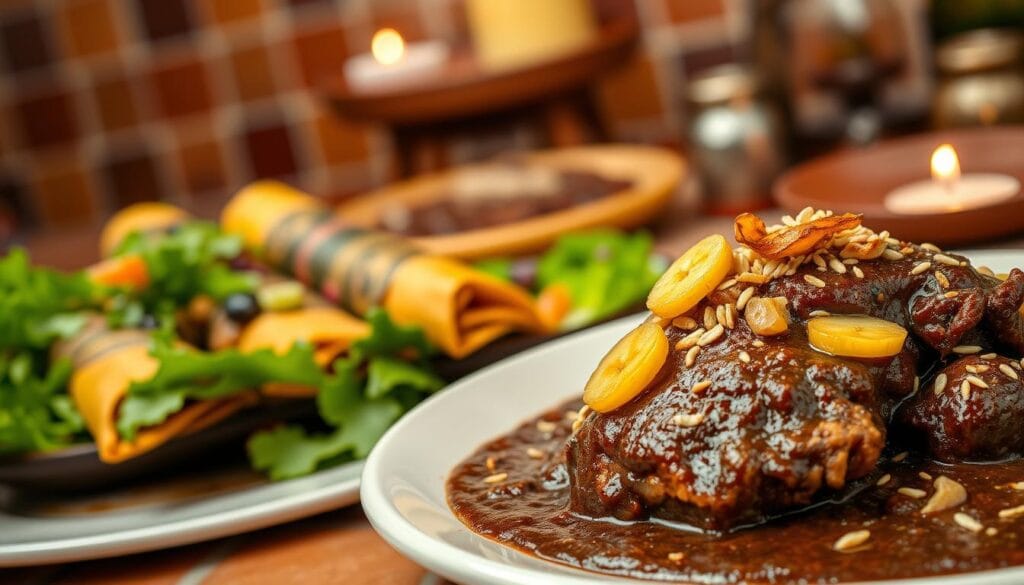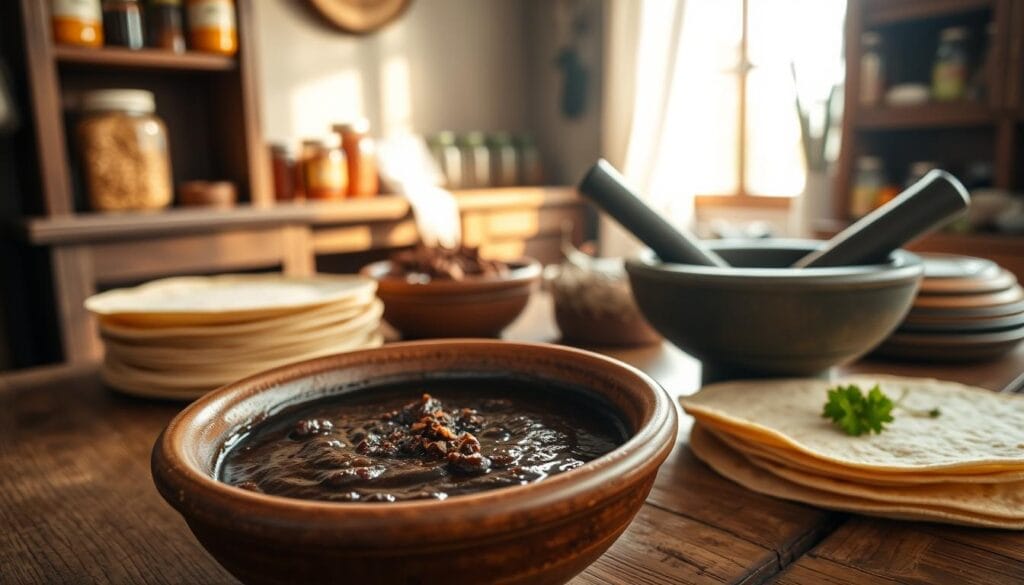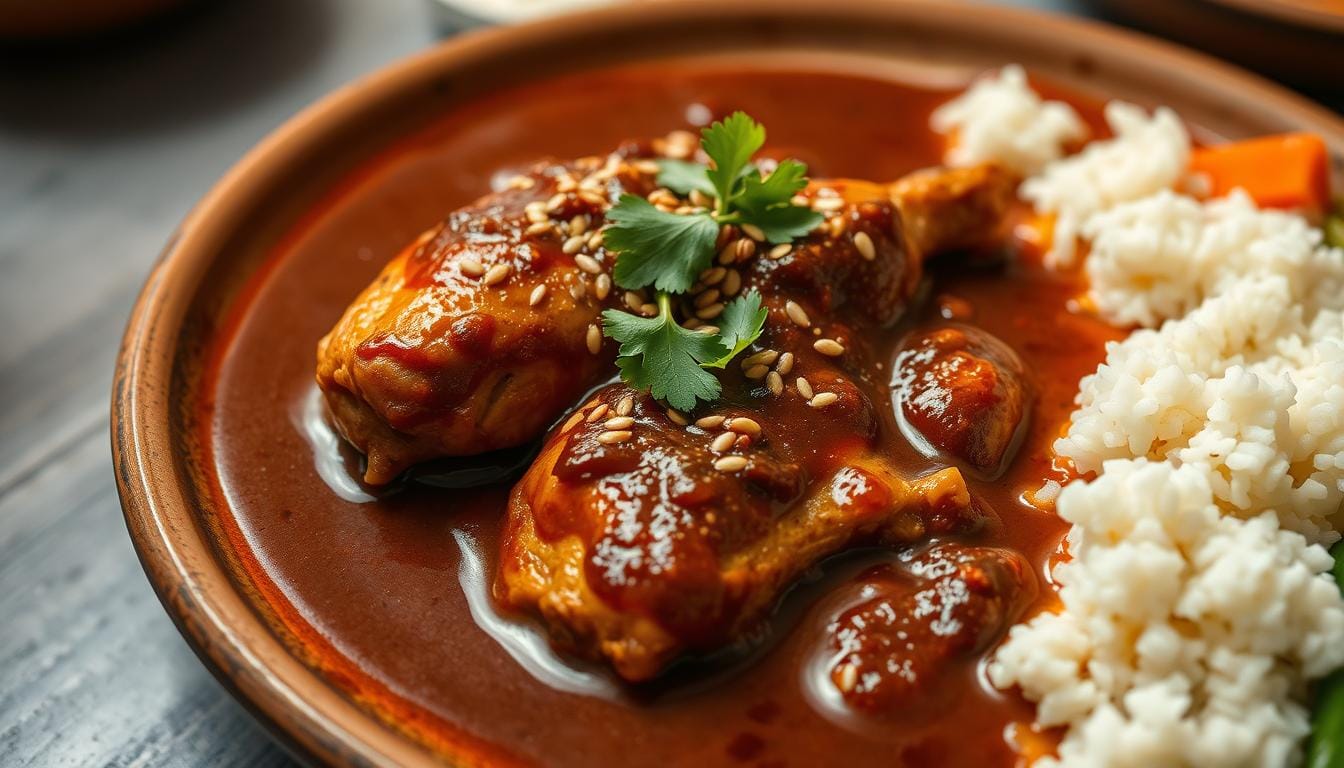Every family has a special dish that brings them together. For many, that dish is Mole Poblano. It’s a mix of flavors that tells the story of Mexican cuisine.
Imagine the smell of Mole Poblano filling the air. It takes you back to happy times with family and friends. This dish is not just food; it’s a way to connect and share love.
As you learn about Mole Poblano, you’ll see it’s more than a recipe. It’s a celebration of culture and heritage. It’s as rich and complex as the dish itself.
Key Takeaways
- Mole Poblano is celebrated as a key dish in Mexican cuisine.
- The mole sauce features a complex blend of spices, including chilies and chocolate.
- This dish is often shared during family gatherings and celebrations.
- Understanding the history of Mole Poblano enhances appreciation for its flavors.
- Mole Poblano showcases a fusion of indigenous and Spanish culinary traditions.
The History of Mole Poblano
The origins of mole poblano are deeply rooted in Puebla specialty. It beautifully combines indigenous ingredients with European influences. This rich sauce is believed to have been created by nuns in the Santa Clara convent.
They used what was available during the visit of a noteworthy archbishop. The story reflects the creativity blossoming from limited resources. It marks an essential moment in mole history.
Origins in Puebla
Puebla is the birthplace of this iconic sauce. Its creation showcases the vibrant culinary traditions of the region. The unique combination of chili peppers, chocolate, and spices not only elevates the flavor profile.
It also represents the cultural heritage of Puebla. As the dish gained recognition, it transitioned from a local delicacy to a celebrated symbol of Mexican cuisine.
Influence of Spanish Conquest
The influence of Spanish cuisine significantly shaped the evolution of mole. Spanish colonizers introduced various ingredients such as almonds, sesame seeds, and spices. These ingredients contributed to the complexity and richness of mole poblano.
These adaptations melded with local ingredients, fostering a culinary fusion. This fusion enriched the dish further.
Evolution of Mole in Mexican Cuisine
Over the years, mole has undergone remarkable transformation. Today, its variations reflect regional flavors and ingredients. This showcases the mole evolution across different areas of the country.
From mole negro to mole verde, this beloved sauce continues to inspire chefs and home cooks alike. It maintains its status as a staple in Mexican culture.
Understanding Mole: What is Mole Poblano?
Mole is a world of rich flavors and traditions. The term “mole” comes from the Nahuatl word “molli,” meaning “sauce.” Mole Poblano is famous for using chocolate, which gives it a unique taste.
Definition and Meaning of Mole
Mole is a traditional Mexican sauce. It’s made from dried chilies, nuts, seeds, and spices. Each mole has its own taste, showing the diversity of Mexican cooking.
Difference Between Mole Poblano and Other Moles
Mole Poblano is special because it includes chocolate. Other moles, like Mole Negro and Mole Verde, have their own flavors. Mole Negro is darker and smokier, while Mole Verde is fresh and green.
| Mole Type | Color | Main Ingredients | Taste Profile |
|---|---|---|---|
| Mole Poblano | Brown | Chocolate, chilies, nuts | Savory with chocolate notes |
| Mole Negro | Dark Brown | Dried chilies, spices | Rich and smoky |
| Mole Verde | Green | Green chilies, herbs | Fresh and vibrant |
Mole Poblano Ingredients: The Heart of the Recipe
The heart of Mole Poblano is its rich mix of *mole ingredients*. Each part is vital for its unique taste. A blend of spices, chilies, and more makes it unforgettable.
Essential Chilies for a Rich Flavor
Ancho, pasilla, and mulato chilies add depth to Mole Poblano. Anchos bring sweet, fruity flavors. Pasilla adds smokiness. Mulato gives a rich chocolate taste. Together, they form a complex base for authentic mole.
Other Key Ingredients: Nuts, Seeds, and Spices
Almonds and sesame seeds add creaminess and texture. They enhance flavor and make the sauce thicker. A mix of spices adds to the overall taste, ensuring every flavor is present.
Sweet vs. Savory: The Role of Chocolate
Mexican chocolate is key to balancing sweet and savory in Mole Poblano. It rounds out the sauce and complements spices. Knowing how to use Mexican chocolate is essential for making this dish.
Traditional Mole Sauce Preparation
Making Mole Poblano is an art that shows in its traditional preparation. This process brings out the best in its ingredients. First, toasting enhances the nuttiness and richness, creating a deep flavor. Then, blending and cooking the ingredients are key to a delicious sauce.
Ingredients Toasting Process
Toasting each ingredient is a critical step in making mole. Chilies, nuts, and seeds need to be toasted carefully to release their flavors. Here’s how to toast them:
- Heat a dry skillet over medium heat.
- Add the chilies first, toasting them lightly until fragrant.
- In the same skillet, toast nuts and seeds until golden brown, stirring frequently.
- Allow the toasted ingredients to cool before moving on to the next step.
Steps to Blend the Mole Ingredients
After toasting, it’s time to blend the ingredients. The goal is to get a smooth mix:
- Transfer the cooled toasted ingredients to a blender.
- Add reserved chicken broth gradually to facilitate blending.
- Blend until a smooth paste forms, making sure no lumps remain.
Cooking Techniques for Optimal Flavor
Cooking techniques are vital for the best taste in Mole Poblano. After blending, follow these steps:
- Pour the blended mixture into a large pot over medium heat.
- Simmer gently to allow flavors to meld, stirring frequently to prevent sticking.
- Taste and adjust seasoning, incorporating additional spices or sweeteners to balance the flavor.

Mole Variations: Exploring Other Types of Mole
Mole is more than just a sauce; it’s a variety of styles with unique flavors and rich history. Learning about mole variations can deepen your love for this Mexican tradition.
Mole Negro: A Darker Alternative
Mole Negro is known for its dark, smoky taste. It uses dried chiles like chipotle and pasilla. Dark chocolate adds to its rich flavor. It’s a favorite for turkey or chicken, perfect for celebrations.
Mole Verde: A Fresh and Bright Take
Mole Verde is bright green and tastes fresh. It uses tomatillos, green chiles, and herbs. This mole is lighter, great with chicken or pork. It’s a refreshing choice, perfect for summer.
Regional Mole Specialties in Mexico
Mexico is home to many mole specialties. In Oaxaca, Mole Amarillo is famous for its yellow chilies and spicy taste. Mole Rojo, found in many states, uses red chiles and pairs well with meat. Each region’s unique ingredients make mole recipes special.
Popular Dishes Featuring Mole Poblano
Mole Poblano brings a unique flavor to many dishes. Chicken mole is a favorite, showing off the sauce’s rich taste. Mole enchiladas also offer a tasty twist on traditional enchiladas. These dishes not only excite your taste buds but also warm your heart with their comforting nature.
Chicken with Mole: A Classic Combination
Chicken mole is a treasured dish, with chicken cooked in a spicy, chocolatey sauce. This mix of flavors makes the chicken a must-try for mole fans. It’s perfect for any special meal.
Mole Enchiladas: A Delicious Twist
Mole enchiladas mix a classic with mole sauce. Corn tortillas filled with meat or cheese are smothered in mole and baked. This combo is a hit, blending flavors in a new way.
Serving Suggestions: Rice, Tortillas, and More
Pairing dishes with mole with the right sides is key. Mexican rice and warm tortillas are great for soaking up the sauce. A sprinkle of cilantro or queso adds to the flavor and looks. It makes every meal special.

Where to Find Authentic Mole Poblano
In Puebla, you’ll find many traditional eateries serving authentic mole. These places use old recipes to bring out the rich flavors of Mole Poblano. Mexico City also has great spots for mole, each with its own twist. Exploring different parts of Mexico shows how this sauce has evolved.
Must-Visit Restaurants in Puebla
Puebla is where Mole Poblano was born. Its restaurants are true to the tradition. Here are some must-visit places:
- El Mural de los Poblanos – Known for its historical ambiance and a wide mole menu.
- La Casa de los Muñecos – A local favorite with rich flavors and a cozy vibe.
- Fonda de Santa Clara – Famous for family recipes and big servings of traditional mole.
Popular Mole Spots in Mexico City
Mexico City has many restaurants dedicated to serving top-notch mole. Here are some places to try:
- Restaurante Los Danzantes – Offers modern twists on classic mole dishes.
- Mole Café – A cozy spot known for creative mole variations.
- Oaxaqueña – Celebrated for blending traditional mole recipes from various regions.
Local Variations Across Mexico
Every region in Mexico has its own mole twist. Some famous ones to try include:
- Mole Verde – A green sauce made with tomatillos and herbs.
- Mole Rojo – A spicier red mole with different chiles.
- Mole de Olla – A stew-like mole with meats and vegetables.
Making Mole Poblano at Home
Making mole at home is a fun cooking journey. It lets you enjoy this classic dish in its purest form. Follow this guide to make authentic mole and enhance your cooking experience.
Step-by-Step Guide to Create Authentic Mole
First, collect all the ingredients you need. Start by toasting the chilies and spices to bring out their flavors. Then, blend them with chocolate and other ingredients like nuts and seeds until smooth.
Simmer the mole to get a thick consistency. This long cooking time is key to deepening the flavors.
Cooking Tips and Tricks for Success
Here are some tips for making great mole:
- Always toast your spices for enhanced aroma.
- Use high-quality chocolate for the best flavor payoff.
- Blend in batches if necessary to achieve a smooth consistency.
- Adjust seasoning gradually to cater to your taste preferences.
Storing and Reheating Mole for Future Enjoyment
After making mole, it’s important to store and reheat it right. Let the mole cool down completely before putting it in an airtight container. Store it in the fridge for up to a week or freeze it for up to three months.
When reheating, do it slowly on low heat. Stir it often to keep the temperature even.

| Storage Method | Duration | Reheating Tips |
|---|---|---|
| Refrigerator | Up to 1 week | Reheat on low heat, stirring often. |
| Freezer | Up to 3 months | Thaw in the fridge before reheating. |
The Cultural Significance of Mole in Mexican Cuisine
Mole is more than a sauce in Mexican food; it’s a symbol of tradition and identity. It’s a key part of celebrations and festivals, bringing people together. Exploring mole in Mexican culture shows its role in history, flavors, and community.
Mole in Festivals and Celebrations
In Mexico, mole is a big part of festivals and special days, showing joy and celebration. Families come together to make and share mole at weddings, birthdays, and religious events. This strengthens family bonds and honors recipes passed down through generations.
Making mole is a team effort, creating unity and connection among everyone involved.
Mole as a Symbol of Mexican Identity
Mole reflects the heart of Mexican identity. Its complex flavors and ingredients show the mix of cultures, from Indigenous to Spanish. Serving mole at important events shows pride in heritage and cultural roots.
This dish lets families share their stories and highlights the role of food in Mexican identity.
Conclusion
Mole Poblano is a true gem of Mexico’s culinary world. It’s not just a dish; it’s a blend of history and flavors. This traditional Mexican dish excites your taste buds and tells a story of the past.
Whether you enjoy it in a Puebla restaurant or make it at home, it’s a journey of flavors. Mole Poblano brings people together, whether at celebrations or simple meals. It’s a dish that connects us through its rich taste and cultural value.
Exploring Mole Poblano’s flavors is a journey worth taking. It’s more than a sauce; it’s a symbol of tradition. It reminds us to cherish and celebrate Mexico’s rich culinary heritage.

